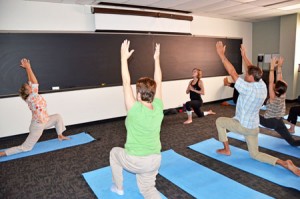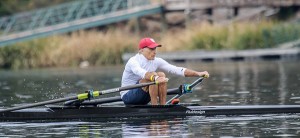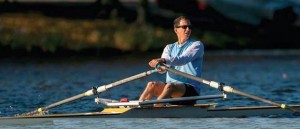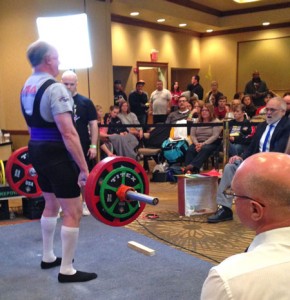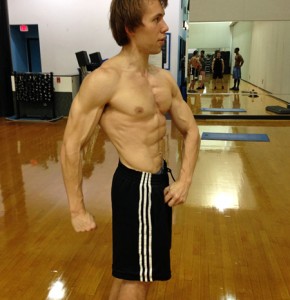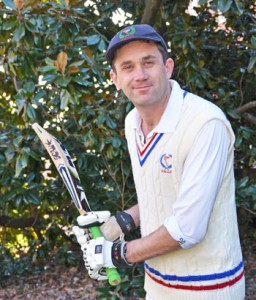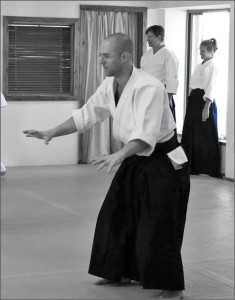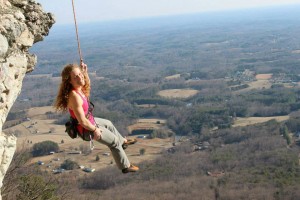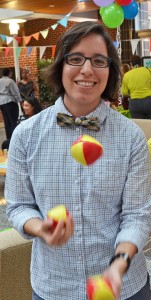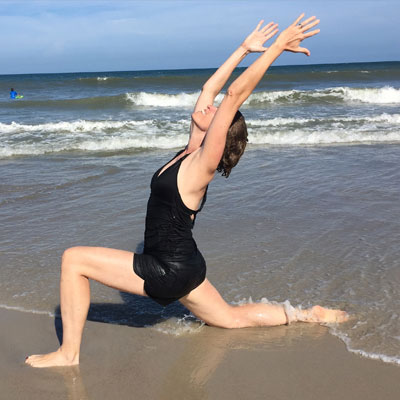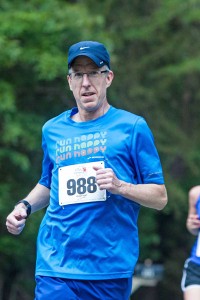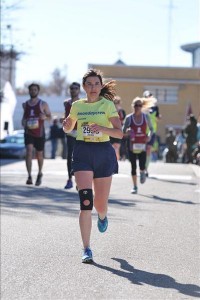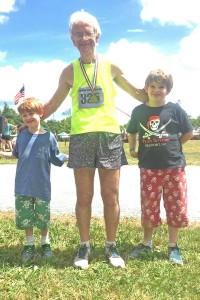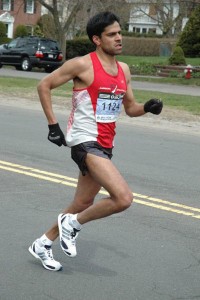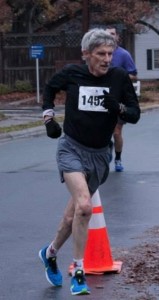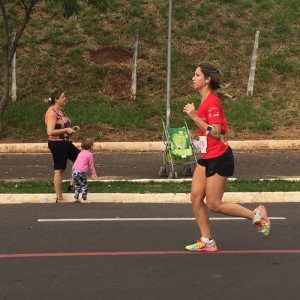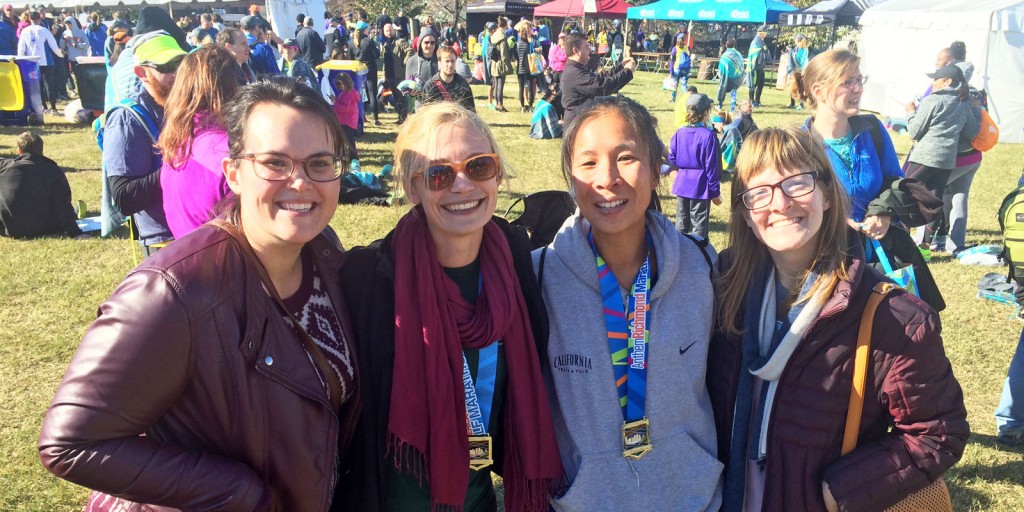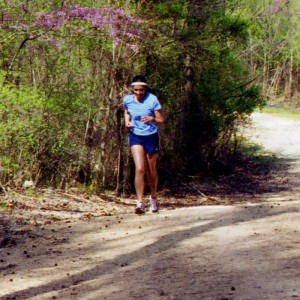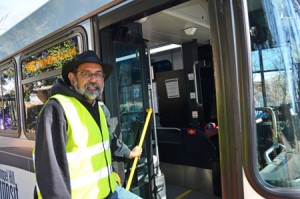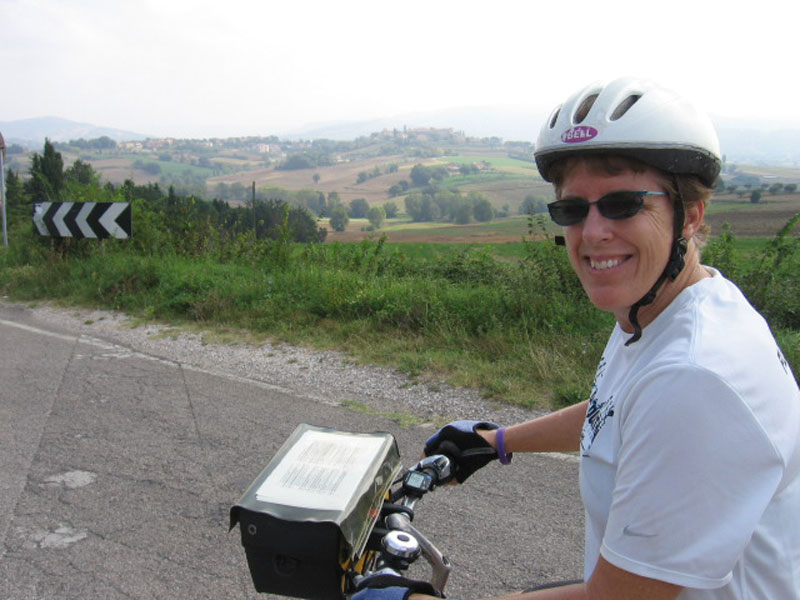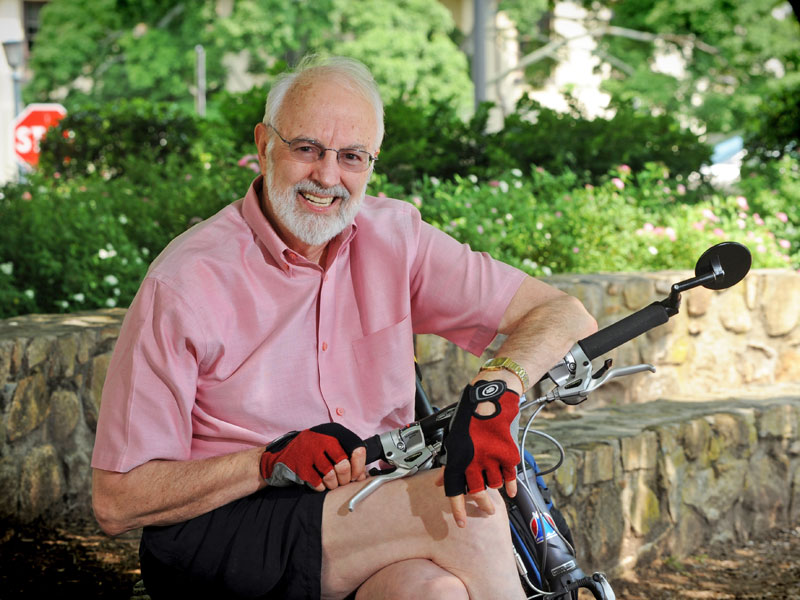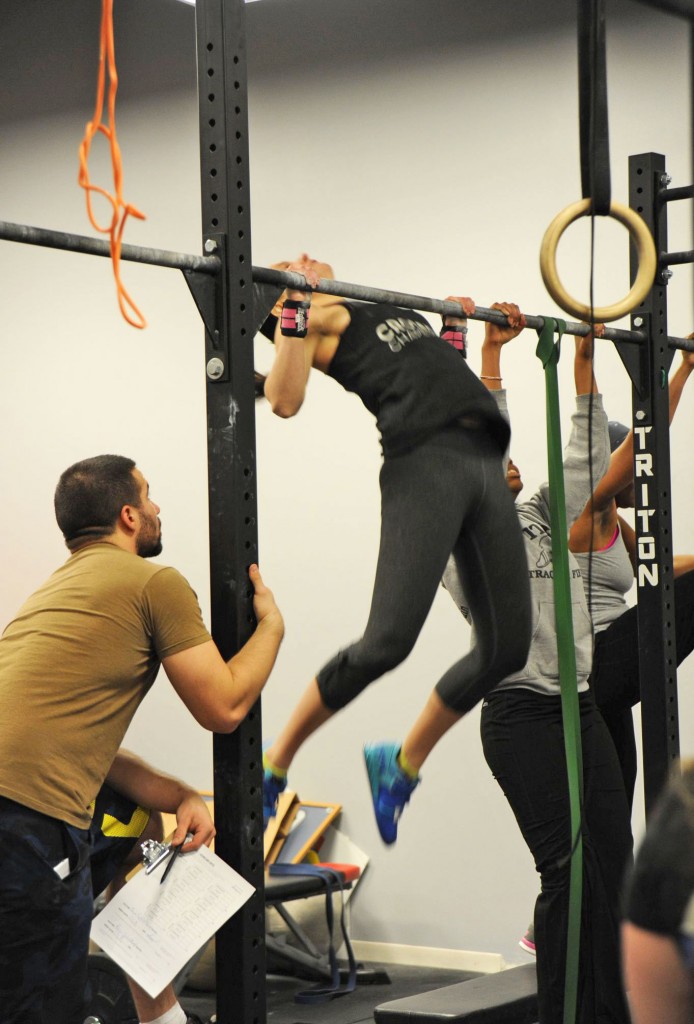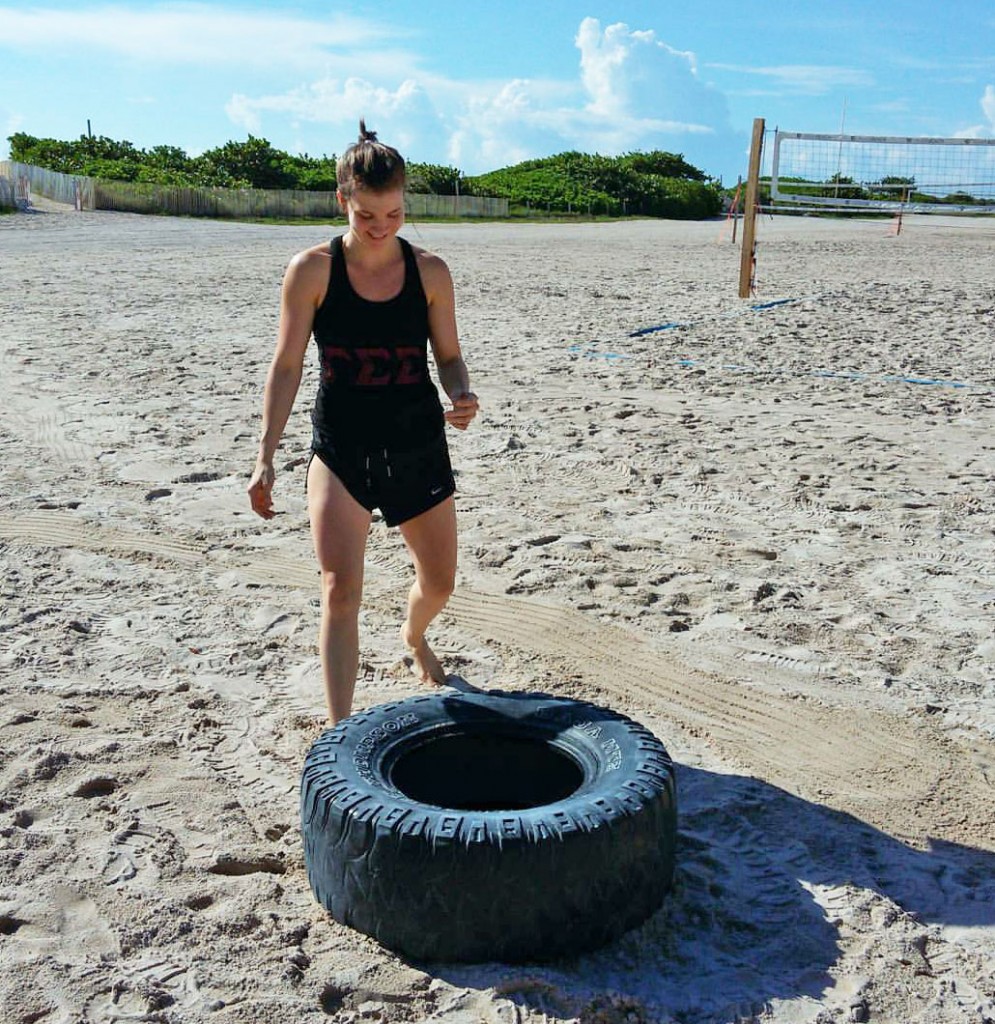Former US Assistant Surgeon General guides the Gillings School toward a ‘culture of health’
February 13, 2016
“Every day, you should take your dog for a long walk – even if you don’t have a dog!” says Penny Slade-Sawyer, with a grin.
Slade-Sawyer, a retired rear admiral in the U.S. Public Health Service, former assistant surgeon general in the U.S. Department of Health and Human Services and former director of the N.C. Division of Public Health, has built a career on promoting – and modeling – good health practices such as eating nutritious food and taking part in regular physical activity.
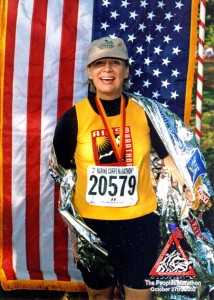
Penny Slade-Sawyer ran in the 2002 Marine Corps Marathon in Washington, D.C., to benefit AIDS research.
She runs, bikes, plays tennis. She has taught aerobics classes and played on a championship basketball team – and yes, she walks her dog between two and four miles each day. Only rarely can one find her standing still.
She joined the staff of the UNC Gillings School of Global Public Health in February 2015, when she was hired to lead a “Culture of Health” initiative at the School, to help encourage those who work, teach or study here to make as many daily healthy choices as possible.
“Risa Lavizzo-Mourey, MD, president and chief executive officer of the Robert Wood Johnson Foundation [RWJF], began using the phrase ‘culture of health’ a while ago,” Slade-Sawyer says. “RWJF began an initiative ‘to encourage individuals, businesses, government and organizations to foster healthy communities and lifestyles,’ and Dr. Lavizzo-Mourey foresaw a vibrant American ‘culture of health’ in which all of us would try a few new things to preserve and improve our health.”
Slade-Sawyer says that Barbara K. Rimer, DrPH, dean and Alumni Distinguished Professor at the Gillings School, responded to RWJF’s challenge, supporting the School community in developing its own culture of health. “In this way,” Slade-Sawyer says, “we’re all able to play a part in developing a healthier America.”
Since her arrival, Slade-Sawyer has taken on a number of initiatives.
Research has shown that a sedentary lifestyle contributes to any number of chronic diseases, and all-day sitting is a practice Slade-Sawyer has targeted. She has mapped out – and leads – regular 10-minute walking breaks for people at the Gillings School, guaranteeing that they leave their desks and computers periodically. (See maps for walking routes here.) She has advocated for hourly “activity breaks” for staff members, who now can place a colorful laminated card on their closed doors while they walk, run or use one of the School’s walkstations.
Stepped out for physical activity, the card reads. Back soon!
At a more formal level, she has instituted regular yoga classes and mindfulness sessions, drawing a small but loyal group of people eager to stretch their bodies and minds in the middle of the day. She has held events offering samples of healthful snacks, along with their recipes, and invited the owner of two therapy dogs to visit the atrium during exams to relax students and relieve stress. Other events, including informative talks about the importance of getting sufficient sleep, are being planned for the coming months.
“The response from faculty and staff members – and students – has been so positive,” Slade-Sawyer says. “Many people in the Gillings School community already are engaged in healthy lifestyles, and they exercise on their own. They have expressed strong support for our efforts to spread the word about the benefits of physical activity.”
Slade-Sawyer would like to see everyone develop a “physical activity habit” to improve and maintain health.
The U.S. Department of Health and Human Services’ Physical Activity Guidelines for Americans, she notes, recommends that adults spend 2.5 hours each week engaged in moderately intense aerobic activity (such as brisk walking or tennis), or 1.25 hours of intense aerobic exercise (such as jogging or swimming laps), or some equivalent combination of moderate and vigorous movement.
“Physical activity is essential,” she says, “but a number of elements lead to our having a ‘culture of health.’ Eating healthfully, learning to handle stress, getting enough sleep – these things profoundly affect our health now and in the future. Poor diet, lack of physical activity and high stress are associated with many of the chronic diseases that kill us.”
We’re well on the way: People at the Gillings School are an active bunch!
How do people at the Gillings School stay fit? Faculty and staff members – and students – took time recently to report some of the physical activities they enjoy. From the routine to the more exotic, their favorite sports and activities keep them healthy – and, they report – happy.
Walking, running (including in marathons), biking and yoga were high on the list of common activities. People who wrote in to say they were “active for life” in these ways are listed below, but first, take a look at some of the more unusual ways members of the Gillings School community exercise!
Sculling
Avram Gold, PhD, environmental sciences and engineering (ESE) professor, and David Margolis, MD, epidemiology professor, are among those who scull competitively.
“Sculling is similar to crew,” Gold says, “except the rower uses two oars rather than one. Both my wife and I compete in single races at the masters’ level. Training is very rigorous, and many of the master-level scullers are former National Team members and Olympians, so the competition is strong. Even in our age groups, the times are outstanding. It just goes to show that one can be really good at this activity for a very long time.”
Gold is 74, and his wife is 62.
Weight lifting / Bodybuilding
Byron Jaeger is a fourth-year doctoral student in biostatistics. “I have been a competitive natural (drug-free) bodybuilder for several years,” Jaeger writes. “I no longer compete in formal competitions, but I still live the lifestyle very enthusiastically.”
Jaeger credits improved diet and activity with helping him lose more than 100 pounds.
ESE professor Casey Miller, PhD, is a competitive powerlifter. He says keeping his muscles working makes him feel healthy and young.
“The photograph,” he writes, “is of me at the USA Powerlifting Association Raw Nationals meet (Oct. 14-18, 2015, in Scranton, Pa.) I’m successfully completing a deadlift with 473 pounds. I finished second in this national meet in my age and weight class.”
Rugby
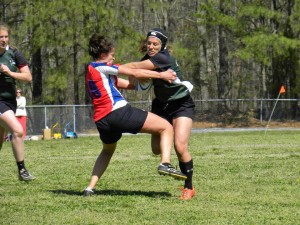
Claire Tipton (center, right) practices the ‘stiff-arm’ maneuver against an opponent from the Charleston-Savannah rugby team.
ESE master’s student Claire Tipton has played rugby for seven years, first at Elon University and now for a club team, Eno River Women’s Rugby, in Durham, N.C.
“Rugby is a fantastic sport comprised of a great community of men and women,” Tipton said. “Rugby rules are the same for both men and women’s teams, although we normally play on separate teams.”
Cricket
Wake Harper, student services assistant manager in ESE, is a native of Auckland, New Zealand. He started playing cricket as a child and continues playing in a local league in Morrisville, N.C.
“I enjoy the camaraderie of the game,” he says, “and it also promotes hand-eye coordination, teamwork and general fitness.”
Like baseball, Harper says, the game has complex rules and is associated with many interesting traditions. At the international level, cricket matches can last from one-half day to five days. The shorter formats are played in his local league.
Martial arts
Mike Fliss, doctoral student in epidemiology, has practiced and taught martial arts – primarily aikido and chen-style tai chi – for about 25 years.
“The most important part of training, for me,” he says, “is training the mind and the body so that it can last longer and be healthier. Martial arts also can train your personality. Often anger, stress, combativeness and ego tighten the body and weaken one’s technique.”
Fliss says he’s glad leaders at the Gillings School are focused on creating a culture of health. “Maybe we could think about classes that are longer than an hour having standing-up breaks,” he says. “Some days, I feel like I’m getting a PhD in ‘sitting’!”
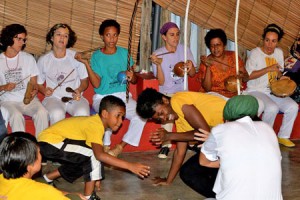
Dr. Courtney Woods (center, right, in yellow shirt) participates in a capoeira angola circle. Photo courtesy of Rita Barreto.
Courtney Woods, PhD, lecturer in ESE, enjoys capoeira angola, an art form with Afro-Brazilian roots, that promotes a culture of health among its practitioners and within the communities it serves.
“Regardless of whether one considers it a martial art, a sport or a dance,” Woods says, “capoeira angola, in essence, is a holistic practice that offers mental, spiritual and corporeal healing. In the ‘roda’ (circle), players are encouraged to stay in the moment with each moment bringing possibilities to demonstrate playfulness, aggression, deception, submission, cooperation – and always – transformation. For me, the roda is also symbolic of life, which daily brings new challenges to which I must remain mindful.”
Rock climbing
Joy Cox, research assistant in nutrition, is an avid rock climber.
“Climbing challenges me physically and mentally,” Cox says. “Want to know a fun fact? I’m scared of heights, so I’ve had to learn how to expand my comfort zone greatly to compensate. I also crave being outdoors and unplugged – no laptops, emails or cell phones. I think it’s necessary to disconnect periodically from all the distractions. Through climbing, I’m able to continually push the limit of what I can do – climb harder routes, conquer taller routes – you name it; I want to do it.”
Cox also is an active runner and yogi. She recently competed in her first Spartan Race in Atlanta, which will be televised on NBC in April.
Ashley Williams, research assistant in ESE, is a rock climber, too. She also enjoys running and scuba diving.
Juggling
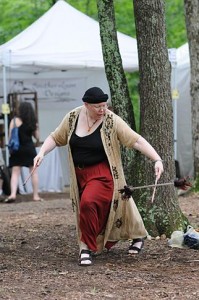
Cait Hill says stick dancing is not only great fun — it’s effective physical therapy, too. Photo by Scott Clevenger.
Cait Hill, systems analyst in the Gillings School’s Information and Instructional Systems (IIS) unit, enjoys a type of juggling called “stick dancing” or “devil sticks.”
She was introduced to the technique when she started playing with a pair of sticks her roommate had purchased at a renaissance fair.
“I actually began stick dancing in a serious way,” she says, “when I needed a low-impact, whole-body exercise for physical therapy after I developed repetitive stress in my shoulders and wrists while I worked at IBM. I wasn’t doing the prescribed stretches because they were boring and painful. Then I came across a video about using the sticks as physical therapy. Stick dancing increases upper-body strength, flexibility and cardiovascular strength, if you go fast enough. Of course, they’re great for hand-eye coordination, and they do all that in a fun and interactive way that is tremendously entertaining to both the stick dancer and to anyone watching.”
Hill used to juggle the sticks set on fire, but these days, she mostly “sticks” to the unlit version. [Photos are from the Eno Festival and from Hill’s days as a fire performer.]
Naya Villarreal, MPH, program coordinator for the Gillings Global GatewayTM, likes to vary her routine to keep exercise interesting — and is always eager to find new ways to stay active.
“At the gym, I run on the treadmill,” she says. “I used to play on the Gillings School’s softball team until the Recreation Center stopped offering it. This winter, I took up golf. And I’m always putting my hidden talent to good use – juggling! It’s a great arm workout if you do it for long enough.”
Tennis
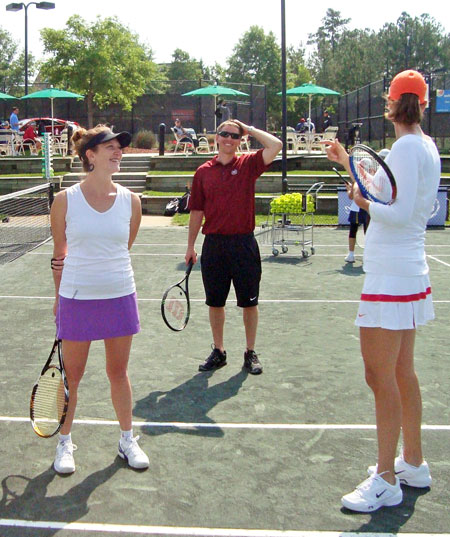
Christin Daniels (left) takes a break on the court with Lindsay Davenport, former World #1 player (on right).
Christin Daniels, MA, director of research in the Research and Innovation Solutions office, discovered tennis in her late 20s and worked her way to “advanced” status.
“I compete throughout the year in the U.S. Tennis Association (USTA) leagues and tournaments in the Triangle area,” Daniels says. “In 2010, I met the man I married while on the tennis court, so it’s a special game to me. We hit groundstrokes with each other before we even spoke.”
In November 2015, Daniels’ USTA team earned a bid to compete at the States Tournament in Wilmington, N.C. Over the New Year’s holiday, she competed in an indoor tournament at Duke’s Sheffield Tennis Center.
“Tennis is a full-body, lifelong sport,” Daniels says. “Players adapt their style of play to their changing physical needs as they age. It’s also one of the few sports through which you can fulfill your social, cognitive and physical needs, all in the spirit of friendly competition. And here’s a bonus – when a match is over, you find your Fitbit has recorded 14,000 steps!”
The photo shows Daniels with Lindsay Davenport, former World #1 player, when Davenport was part of a promotional event in Raleigh, N.C.
Laura Loehr, PhD, research assistant professor of epidemiology, started playing tennis when she was seven years old and played on the Davidson College team. “My league team and I have played in the state tournament, southern state, and once, went to nationals,” she says. Loehr also trains at Orange Theory Fitness, which is her cross-training for tennis.
Crystal Hinson Miller, MA, CFRE, associate dean for advancement, is co-captaining a USTA 2.5 tennis team this winter. She also enjoys water skiing.
Yoga
“I’ve loved the twice-weekly yoga classes that Penny Slade-Sawyer has organized,” says Jayne Boyer, PhD, research analyst in ESE. “We have a small group of loyal participants who really enjoy the classes.”
Leslie Lytle, PhD, professor and chair of health behavior, says yoga and running are part of her active lifestyle.
“I’m a huge yoga fan,” says Alison Stuebe, MD, associate professor of maternal and child health. “I practice several times a week at Franklin Street Yoga – and also bike (or take my bike on the bus) almost every day.”
Ultimate
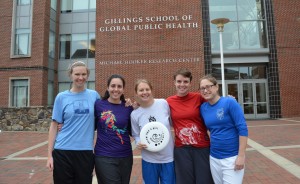
Left to right are Ultimate team members Meghan Miller, Adrien Wilkie, Elle Glenny, Cory Keeler and Chani Hodonsky.
Chani Hodonsky, doctoral student in epidemiology, sent a shout-out for her interdepartmental Ultimate (Frisbee) team. Doctoral student team members include Adrien Wilkie (epidemiology), Cory Keeler (geography), Meghan Miller (ESE) and Elle Glenny (nutrition).
“Playing a team sport is a real stress-reliever,” Hodonsky says. “It’s also unusual to be able to associate with people outside of your department during a doctoral program. Ultimate has provided a unique opportunity to get to know other women at the Gillings School and stay active at the same time.”
Running
From 40-year marathon runners to those who jog daily on roads and trails, the Gillings School community includes a surprising number of serious runners.
Alessandra Bassalobre Garcia, MSc, BSN, doctoral student in health policy and management, finds regular activity keeps her calm and centered.
“Running makes me feel physically strong and well,” Bassalobre Garcia says, “but it also helps me to arrange my thoughts. I run to work my body and rest my mind.”
David Couper, PhD, clinical professor of biostatistics and deputy director of the Collaborative Studies Coordinating Center, has participated in marathons for 40 years.
“Running is probably more of a habit than an enjoyment,” Couper says. “It is a sport I have been reasonably good at. It doesn’t require much equipment, and I can do it from home, without needing to drive anywhere. Also, on weekdays I usually run in the late afternoon, which helps to relax after getting home from the office. A run often provides an opportunity to mull over a problem, away from distractions.”
Sonia Davis, DrPH, Professor of the Practice of biostatistics and director of the Collaborative Studies Coordinating Center, enjoys running on roads and trails to relax and keep in shape.
When she was younger, Christelle Douillet, PhD, research associate in nutrition, participated in ultra-long-distance swimming events – as in 24 hours, nonstop. “Now, I have fun running multiple marathons each year,” she says. “Last year, I ran 31 full marathons and one ‘ultra.’ I’m planning to do more in 2016!”
Jackie MacDonald Gibson, PhD, ESE associate professor, won first place in the Grand Master’s Division and 239th overall in a field of 2,512 at the St. Jude’s International Marathon, in Memphis, on Dec. 5, 2015. MacDonald Gibson ran the annual charity race in 3:38:04, with an average pace of 8:20.
More than 20,000 people participated, including in half-marathon and 5km races.
Jon Hussey, PhD, research assistant professor of maternal and child health, loves running – from 5k races to marathons.
Sydney Jones, epidemiology doctoral student, has been running with her friend and classmate Rebecca Yau since they started the program 3.5 years ago.
“We’ve run a number of races together in the Chapel Hill area,” Jones says. “We say ‘hi’ at the start, and she cheers me on at the finish. (Rebecca is almost twice as fast as I!) We were glad to have our classmates Ricky Camplain and Jordan Cates (excellent cheerleaders) after running the Richmond, Va., half-marathon (me) and marathon (Rebecca) in November 2015.”
Jones has participated in the Fleet Feet Pub runs, which she says are a great way to feel integrated with the community. “I use running as a way to explore new neighborhoods in Chapel Hill and Carrboro,” she says. “The woods behind Wilson Park are a favorite spot.”
Jones also practices yoga daily and “tries to stay active in small ways throughout the day – walking to or from campus, taking the stairs, or doing a lap around the office suite to break up my computer time.”
Sloane Miller, doctoral student in ESE, is a triathlon athlete.
|
|
Kavita Singh Ongechi, PhD, research associate professor of maternal and child health and senior technical adviser for maternal and child health at Carolina Population Center’s MEASURE Evaluation Project, runs regularly, about 15-20 miles each week.
“I’m not particularly fast, and I’m not a competitive runner,” Ongechi says. “I just run for fun and fitness. Running can be full of small triumphs, such as running a little faster or farther than you have before. Running on a quiet trail can be very peaceful and relaxing.”
Richard L. Smith, PhD, professor of biostatistics and Mark L. Reed Distinguished Professor of statistics and operations research, isn’t far behind. He has run a marathon each of the last 35 years.
Harsha Thirumurthy, PhD, associate professor of health policy and management, has competed successfully in marathons for a decade now. Why does he do it? “It gets me outside every day, it’s a terrific way to set personal goals and work to achieve them, and it’s great for mental health!” he says.
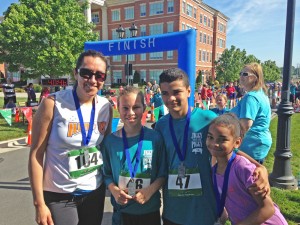
Dr. Itzel Vazquez-Vidal (left) is a postdoctoral research associate in the Voruganti Lab at the UNC NRI in Kannapolis. She is pictured with her running club partners after completion of the ‘Jiggy with the Piggy’ 5K on the N.C. Research Campus in May 2015.
At the UNC Nutrition Research Institute (NRI), staff members definitely practice what they teach – and they’re educating children in the Kannapolis community at the same time.
In 2013, Julie Macon Stegall, MSW, project coordinator for NRI’s Growth and Development Study, started a running club at Shady Brook Elementary School. Since then, NRI representatives have been supporting children and adults to be active and healthy together. Children who run with the researchers also learn about healthy snacks, appropriate beverages, and even monitor their own diet routinely as a part of the program.
“Kannapolis City Schools have a high rate of participation in the free and reduced-cost lunch program,” Stegall says. “We’re so glad to be able to work with these kids to help teach them about the importance of good nutrition and regular physical activity.”
Approximately 50 children have been a part of each of the running clubs. They created walking salads, a tofu chocolate mousse and blueberry banana smoothies for their end-of-year celebration as they tried to explore how to choose healthy snack foods. This year, the program will expand to include children at Kannapolis Intermediate School, located just blocks away, and will allow more researchers to step away from their desks for an afternoon break to help others – while helping themselves.
“I enjoyed being able to demonstrate to my running buddy that when you set a goal – such as a time to finish a race – you may experience obstacles,” says Andrea Armer, MA, NRI researcher and running club participant. “However, the only way to reach your goal is to challenge yourself!”
“Being part of the running club means not having to run alone,” says Tracey He, MS, a 2013 Gillings School graduate who was the first nutrition student based on the Kannapolis campus. “I enjoyed the team spirit, mutual encouragement and the happiness of achieving goals together.”
There are now a dozen NRI researchers who are involved in the Kannapolis Intermediate School community running program.
Walking/Hiking
“Does walking 1.5 miles to the nearest bus stop qualify as ‘interesting physical activity’?” asks Kant Bangdiwala, PhD, research professor of biostatistics.
“Since I live in Heritage Hills – outside the Chapel Hill-Carrboro city limits, we get no bus service,” he says. “The nearest bus stop is the CCX Park & Ride, 1.4 miles from my house.”
In order to be ecologically correct – and also get in his 10,000 steps/day as exercise – he walks to the bus.
“That’s not a big deal – it only adds about 25 minutes to my daily commute each way,” he says. “The problem is the short stretch where I must walk on Smith Level Road, a two-way street with no sidewalks or decent shoulders. In the winter, it gets dark early, so I use a reflective vest – given to me by the Lidkoping Community in Sweden, when I attended a Safe Community Conference in 2014.
“I walk facing traffic, use the vest, and pray! Maybe one day, vulnerable walkers will be assisted by giving us sidewalks!”

Dr. Amy Herring (second from left, leading the way) outpaced her grandmother on this hike in Switzerland.
Amy Herring, ScD, Carol Remmer Angel Distinguished Professor of Children’s Environmental Health and associate chair of biostatistics, enjoys running and hiking. Always up for a challenge, she agreed to take a lunchtime hike during a recent conference in Lenzerheide, Switzerland.
“We were trying to think happy thoughts about the colleague who had described the trek as ‘something your grandmother could do,’ Herring says. “I decided Grandma would need a sleigh and a pack of dogs for that one – not to mention a warm fur coat and some gluhwein!”
Biking
The Environmental Sciences and Engineering faculty could launch its own Tour de Chapel Hill.
Mike Aitken, PhD, professor and chair, and associate professors Jason West, PhD, Will Vizuete, PhD, and Marc Serre, PhD, bike to work, no matter the weather.
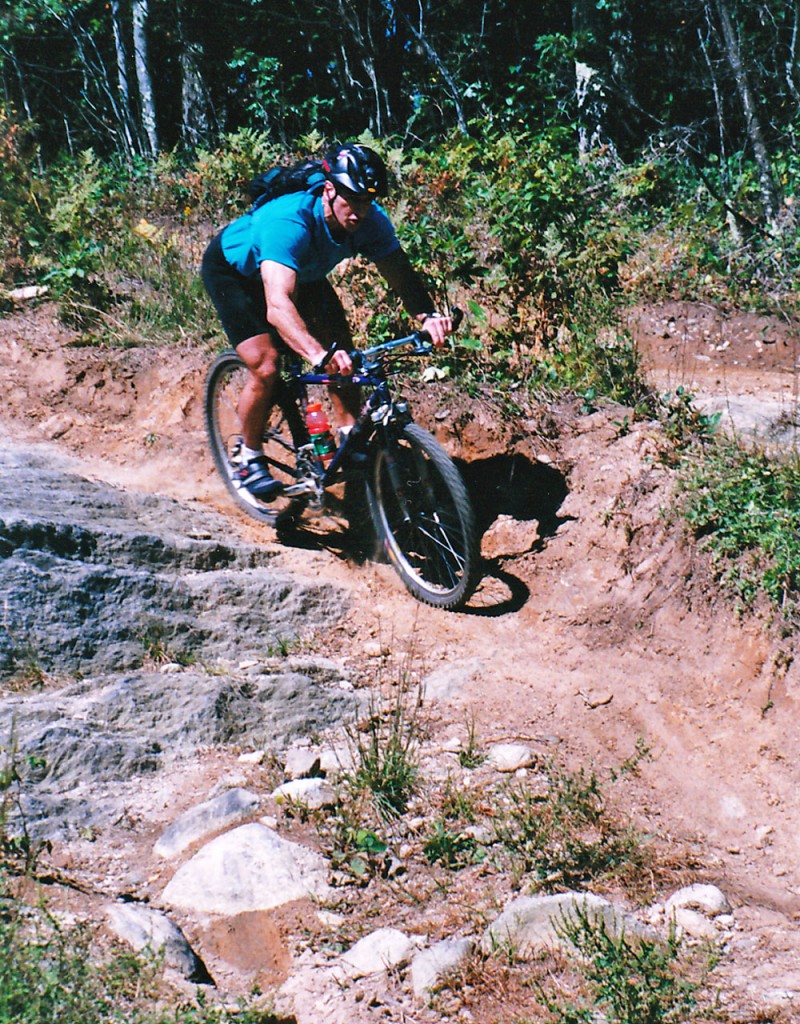
David Pesci finds that mountain biking calls for intense focus, a skill that transfers to other areas of his life.
David Pesci, director of communications at the Gillings School, is a mountain biker.
“I was drawn to mountain biking because of the challenge of the terrain – and because there are no cars in the woods,” he says. “It’s not just physical, either. When I’m on a trail, I have to be completely focused on what’s 10 feet in front of the bike, or I’ll end up with a mouthful of tree bark! It’s a great way to cleanse the mind while invigorating the spirit. It does a good job on the legs, heart and lungs, too.”
Meg Pomerantz, MA, project director for the Carolina Collaborative for Research on Work and Health enjoys biking, including on trips abroad.
Barry Popkin, PhD, W.R. Kenan Jr. Distinguished Professor of nutrition, may be wearing his biking shorts under his dress clothes. He bikes to work most days.
“I bike-commute to Carrboro, where we have standing desks in the offices,” says health behavior professor Kurt Ribisl, PhD.
“I bike to work every day – except when the weather is horrible – from my home near McDougle School in Carrboro to my office at the Collaborative Studies Coordinating Center in downtown Chapel Hill,” says Kathy Roggenkamp, MA, research instructor in biostatistics.
Matthew Simon, MA, research associate at the N.C. Institute for Public Health, bikes 2.5 miles to work every day.
“I also enjoy playing competitive sports – Ultimate Frisbee and soccer) and practicing yoga,” Simon says. “Unfortunately, I haven’t figured out how to engage regularly in either since my children were born. This is my new year’s resolution, for sure – better self-care!”
Healthy living
“I’m not sure this is unique,” writes Janine Barden-O’Fallon, PhD, clinical assistant professor of maternal and child health, “but I can tell you about my healthy addiction. I’m a member of the UNC Wellness Center in northwest Cary, and I love taking boot-camp classes there. It’s a challenging, full-body workout, and I’ve been at it for almost 1.5 years!”
“I usually get a lot of exercise at least four days a week,” says Richard Bilsborrow, PhD, research professor in biostatistics. “I usually do three days of tennis and a workout at the gym. I was hoping to scuba dive in Australia over the holidays, but that trip was postponed. If we get snow this winter, I’ll be skiing with my grandchildren – at age 74!”
“I have two young, active children with whom I play soccer and Ultimate Frisbee,” says Jennifer Cole, MPH, MSW, director of career services in maternal and child health. “There’s nothing very exciting, but I lead a fairly healthful lifestyle. I commute by bike to work, have volunteered as a Girls on the Run coach and hike regularly.”
Lewis Margolis, MD, MPH, associate professor of maternal and child health, enjoys starting early each day on the elliptical or treadmill in the Student Recreation Center.
“On two days, I add free weights to my routine,” he says. “I usually top off the week by swimming on the weekend. On my birthday, I swim the number of laps that matches my age.”
Last December, Margolis swam 67 laps.
“I’m a competitive crossfit athlete,” says Paige Schildkamp, master’s student in maternal and child health.
“I work out about two hours a day, five or six days each week, and participate in team CrossFit competitions a few times a year. I’ve become physically and mentally stronger and more confident because of it. I look forward to working out every day to see if I can beat my previous weights or times. I have met a whole community of like-minded people who encourage me, plus – I won’t lie – lifting heavy weights and being able to do pull-ups and handstand push-ups makes me feel really cool – and I really love that feeling!”
Sarah Smith, accounting technician in epidemiology, enjoys weight training. This past year, she also competed in a triathlon.
“For me, a healthy lifestyle is not only a combination of exercise and diet,” Smith says. “It’s a journey on which I’ve learned more about myself than I ever thought possible. I’ve gone beyond what I once thought I could do and seen so many aspects of my life unfold successfully – health, strength, focus, courage and discipline. I love this life because I took what once was a sad person and turned her into someone with love, energy and capability. I never thought I would be strong or at a healthy weight, but after dedicating more than two years to a healthy lifestyle, I am beyond happy about how far I’ve come and confident about what I have left to do.”
[More photos coming soon]
Take a look at this important resource — a list of locations in the Triangle area (trails, parks, fitness centers, etc.) that can help keep you active. Email sphcomm@listserv.unc.edu if you have other locations to add!
Gillings School of Global Public Health contact: David Pesci, director of communications, (919) 962-2600 or dpesci@unc.edu

